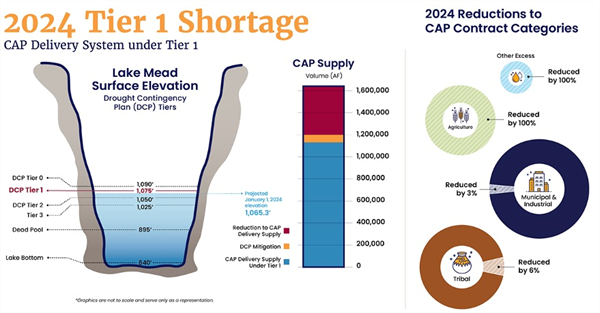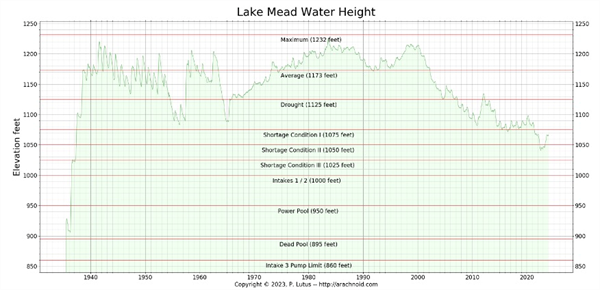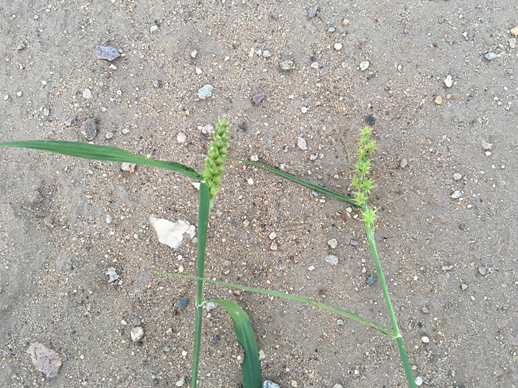
In 2023 Arizona and the lower basin states were operating under Tier 2 reductions, consistent with the Drought Contingency Plans (DCP) for Colorado River conservation in response to the drought conditions (Figure 1). Tier 2 conditions imposed a 592,000 acre-feet (kaf) reduction in Arizona’s 2.8 million acre-feet (maf) total allocation from the Colorado River. These reductions have primarily impacted the irrigation districts in central Arizona.
For 2024, the Bureaus of Reclamation (BoR) has announced in August 2023 that the river operations will follow Tier 1 DCP reductions (Figure 1). That is due to an increase in the water levels in Lake Mead in the past year with an excellent snowpack last winter and above average runoff in 2023. That increase in water level at Hoover Dam in Lake Mead is primarily a function of an excellent snowpack and higher rainfall in the Colorado River basin in 2023. Significant conservation efforts have been employed as well.

Figure 1. 2024 Tier 1 Shortage for the Colorado River operations. Source:
Arizona Department of Water Resources.
With agriculture responsible for 70% of the diversions on the Colorado River, tracking the snowpack is an important exercise for forecasting and managing the precious water resources in this region and this watershed for sure.
The pressures on the Colorado River system because of the drought that has been impacting the entire basin and region for 23 years have slackened briefly due to the wet winter in 2023 with a good snowpack in the mountains, good rainfall throughout the basin, good flows into the river, and conservation.
The current water level at Lake Mead on Hoover Dam is 1,068.25 ft. above sea level on 3 January 2024. That level is 160.75 ft below full pool of 1,229.00 ft. (Figure 2).

Figure 2. Lake Mead water height (feet above sea level at Hoover Dam) history
and critical Tier conditions. Source: U.S. Bureau of Reclamation.
The current snowpack in the Colorado River Basin is at 74% of average and below levels of this time last year. However, hydrological records indicate that most of the snowpack in this basin accumulates between February and April.
So, it is worth watching the snowpack accumulation and it is always good to pray for more snow in mountains to the north for those of us working and living in this desert with a heavy dependence on this water. However, while monitoring the snowpack gives us a capacity to project, none of that really counts until there is water in the river and in the reservoirs, like money in the bank.
I am seeking samples of downy mildew on lettuce from around Yuma County to support the Michelmore Lab and their ongoing efforts to help characterize the downy mildew populations of the United States. The Michelmore Lab has led the charge on a survey of Bremia variants since 1980 and has been instrumental in demystifying the gene-for-gene nature of lettuce resistance to downy mildew.
Their group invites growers across the United States to submit downy mildew infected plant samples, which are then used to culture the Bremia on live host plants. The team then inoculates a panel of lettuce varieties carrying known resistance genes to determine the race of each isolate they receive. Identifying which races occur in which specific fields is essential to guiding the breeding of new resistant cultivars and maximizing the effectiveness of host-based genetic disease management. The data obtained from these tests are also used to designate new Bremia races through the International Bremia Evaluation Board.
Your contribution will help breed better lettuce for Yuma. This means less breakdown of resistance in the field, and better yields for Yuma growers. To facilitate these submissions the Yuma Plant Health Clinic will be setting up a separate drop-off point and submission sheet for downy mildew sample submissions in the same hallway we use for standard plant diagnostic submissions. The drop-off point will be clearly labelled and consist of a chest-style refrigerator and printed copies of the submission form. It is vital to keep these samples cool so they remain viable for future inoculations, so please place your samples inside of the refrigerator before you leave.
Shipping will be handled by the clinic. All we ask is that you fill out the submission form as completely as you can. An example of the questions that are asked in that form so you can prepare ahead of time can be found HERE .Mark C. Siemens, Department of Biosystems Engineering
Vol. 14, Issue 16, Published 8/9/2023
Pre-Season Vegetable IPM Workshop
Mark C. Siemens
Vol. 14, Issue 17, Published 8/23/2023
The Pre-Season Vegetable IPM Workshop will be taking place TOMORROW, Wednesday, August 23rd at the Yuma Agricultural Center. Come learn about the latest IPM products, practices and trial results from university and industry experts. Registration begins at 7:30 am and the program starts at 8:00 am. Agenda below. Looking forward to seeing everyone there!
|
Barnyardgrass |
Echinochloa crus-galli |
|
Red sprangletop |
Leptochloa filormus |
|
Prairie Cupgrass |
Eriochloa contracta |
|
Field sandbur |
Cenchrus spinifex |
|
Yellow foxtail |
Setaria glauca |
|
Feather fingergrass |
Chloris virgata |
|
Crowfootgrass |
Dactyloctenium aegyptium |
|
Junglerice (Watergrass) |
Echinochloa colona |
|
Mexican sprangletop |
Leptochloa fusca |
|
Southwestern Cupgrass |
Eriochloa acuminata |
|
Southern sandbur |
Cenchrus echinatus |
|
Green foxtail |
Setaria viridis |
|
Sixweeks grama |
Bouteloua barbata |

Figure 1. Left southern sandbur and right field sandbur